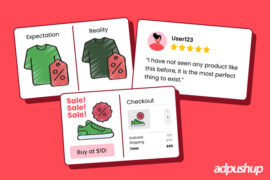
Enhance your online publishing endeavors with Google Analytics by understanding the essential metrics that drive success. Discover valuable insights Google Analytics for publishers has to offer on user engagement, traffic sources, content performance, and more in this guide.
Analyzing the website can help publishers understand their target audience and behavior so that the website can be optimized with the customer journey to suit the special interests and needs of users.
Optimizing user journeys can drive conversion increment, as users are more likely to buy a product/service when their experience with the brand is highly relevant and personal.
By comparing matrices in the data, publishers can gather further insights and identify the reasons and correlations for website user behavior.
Let’s take a look at a few things every Google Analytics report consists of for digital publishers.
Let’s first discuss why Google Analytics for publishers is important.
Why Google Analytics for Publishers is Important?
Google Analytics is a free tracking tool that gives you data on your blog visitors and their actions on your site. With Google Analytics, you can discover how visitors find and interact with your blog, so you can keep them coming back.
Google Analytics is a free service by Google, and it’s the most comprehensive tracking tool for websites of all sizes. You can find several useful, intuitive reports in Google Analytics that tell you everything you need to know about your ad visitors. The best part is, that you don’t have to be an Analytics data expert to analyze the reports.
Google Analytics gives you the most accurate data about your visitors to grow your audience and increase the revenue you generate from your ads.
How to Use Google Analytics to Look Closer at Data?
Now let’s have a look at how Google Analytics for publishers can be used for a closer look at data.
Landing Page Report
If the publisher has linked the Google Analytics property to Google Search Console, the publisher will have two landing page reports. The landing page report in Search Console is located under the acquisitions tab of the Google Analytics dashboard.
However, this report is only limited to landing page data from search results. Site content on the landing page reports on the behavior tab display page data from all traffic sources.
In Google Analytics, a landing page is the first page viewed in a session. So, in a Google Analytics report, the landing page is the entry point when users enter the publisher’s website. By studying the landing page report, publishers can see how the page can generate traffic, and how visitors interact with the website.
In addition, this report also shows the media mix profile, and conversion rates and can be used to increase the base price of the most in-demand inventory in order to better categorize it. To analyze landing page reports, publishers can go to Behaviour > Site Contents > Landing Page.
In-Market Segments
By analyzing market segment reports, publishers can reach potential users who are actively searching or willing to purchase products or services. This can help publishers to target potential users to users who are more likely to convert. In this case, publishers can match relevant ads to display directly with their interests. For example, publishers can find out what type of product or service from direct advertising & PMP (Private Market Place) deals suits their target audience.
To analyze the in-market segments report, publishers can go to Audience > Interests > Market Segments.
Affinity Categories
Affinity targeting shows users who have the longest interest in publisher sites in general. This report analyzes over a long period of time the type of audience that has interests and lifestyles as a whole. Thus, publishers can better understand the user’s identity to determine relevant website content which is always accessible by users at any time.
To understand more, the publisher’s affinity categories report can go to Audience > Interests > Affinity Categories.
Sessions and Pageviews
In engagement reports, session duration metrics and page depth sections, located in the report header are very useful because these reports show the interactions and interests that users have on the website. With this report, publishers can find out whether the site is usually accessed repeatedly by users. On the other hand, publishers can also activate the auto-refresh function on ads on pages with high session duration to increase ad revenue performance.
To learn more about these two matrices, publishers can go to Audience > Behaviour > Engagement.
Source/Medium
This report shows the type of category users come from and the actual domain that sent users to the publisher’s site so that publishers can better see which domains or categories they should really focus on. For example, most of the traffic comes from one of the social media medium sources with a percentage of 50% of all traffic sources, hence publishers can consider improving this strategy. On the other hand, publishers can improve the user experience as well for the lowest-rated medium.
To better analyze the source/medium report, the publisher can go to Acquisition > All Traffic > Source/Medium.
Benchmarking
Benchmarking reports allow publishers to look at trends happening in the industry as a whole to gain insights into how well the site is performing compared to competitors.
Publishers can see green and red flags indicating positive and negative signs of the publisher’s site performance metrics compared to current market performance metrics.
By using this report, publishers can prioritize opportunities to increase investment in time and resource allocation, set realistic goals, maintain competitive advantage, and market benchmarking.
To understand more about benchmarking reports, publishers can go to Audience > Benchmarking > Channel.
Exit Pages
By analyzing this last page in each user session, publishers can make decisions to set up call to action or pop-up alerts to users before they leave the site, for example subscribing to newsletters, and emails or following publishers’ social media pages. If the total page exit exceeds 50%, it can be indicated as an issue.
To analyse exit pages report better publishers can go to Behavior > Site Content > Exit Pages.
Site Speed Suggestions
The site speed suggestions report shows how quickly users are viewing and interacting with content so publishers can identify areas that need improvement, and then track the extent of those improvements. This report is also directly correlated with user experience and search rankings.
In addition, this report also provides a detailed list of data from average page load time and page speed score along with practical guidelines. Publishers can do several things above to increase page speed and ad-delivery speed.
To learn more about the site speed suggestions report, publishers can go to Behaviour > Site Speed > Speed Suggestions.
Search Terms Report
This report shows the actual queries that users have searched and the number of unique searches for each query. Interestingly, in this report publishers can see if people are looking for something that publishers currently do not have in their website content.
In this case, publishers can identify gaps in content that can be filled, making it easier for users to find the content they are really looking for. If there are several existing queries mentioned in the website content, the publisher can re-elaborate on these specific terms to inform the publisher’s product services in more detail.
To analyze search terms report better publishers can go to Behavior > Site Search > Search Terms.
Goal Report
Having goals configured correctly allows Analytics to provide publishers with important information, such as conversion counts and conversion rates for the publisher’s site. Without this information, it is difficult to evaluate the effectiveness of the publisher’s online business and marketing campaigns. In addition, setup goals also help publishers to understand how much resources should be invested, as well as what changes are needed to improve site performance.
To analyze the publisher’s goal report, go to Conversions > Goals > Overview.
In the End
Like with any other analytics tool, let’s just end by pointing out that if you don’t check and analyze the results you attain, it really won’t mean anything and can’t possibly help you improve your site, your traffic, and your revenue. Whether you dig deep into the world of Google Analytics or just want to dabble at the surface level, do something today.
So this was pretty much all you needed to know about how you can use Google Analytics for publishers. Thanks for reading!

Shubham is a digital marketer with rich experience working in the advertisement technology industry. He has vast experience in the programmatic industry, driving business strategy and scaling functions including but not limited to growth and marketing, Operations, process optimization, and Sales.










